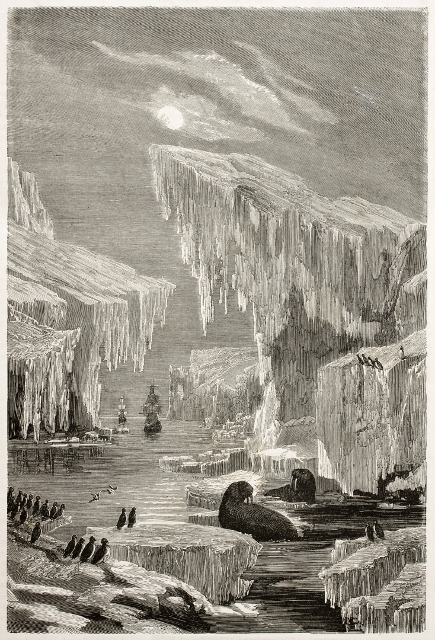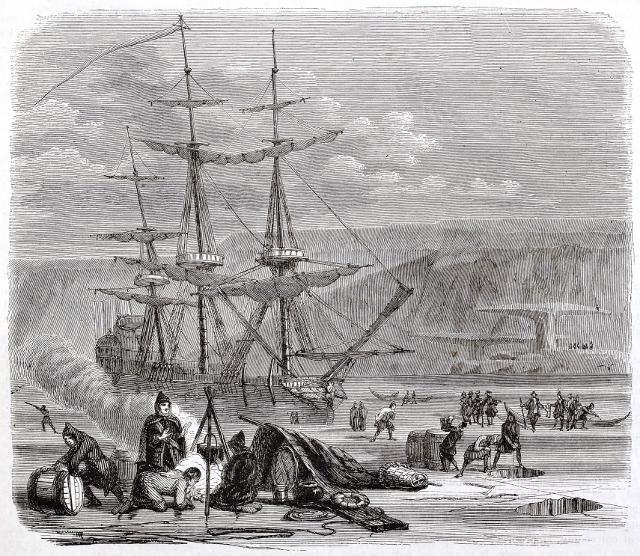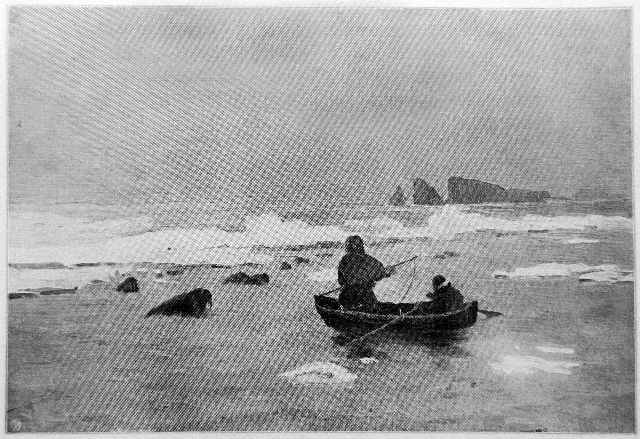On July 21, 1819, the American brig General San Martín became the first trading vessel to reach the Bering Strait. Her captain, Eliab Grimes was capitalizing on discoveries Russians had made there only three years earlier. On the way north from Hawaii Captain Grimes stopped in Kamchatka, where he learned that the Bering Strait natives—Eskimos and Chukchi—were known to be hostile and aggressive. In fact, as soon as the ship reached the Bering Strait the General San Martín was surrounded by a fleet of eighteen large walrus-hide boats with more than two hundred armed natives who refused, at least initially, to allow him to trade.
A trading vessel was a convenient source of foreign goods, and one might assume that the natives would have welcomed it, but the Eskimos and Chukchi were not happy to see the foreign boat. They controlled the cross-Bering Strait fur trade, carrying knives, tobacco, and beads to the natives of Alaska and returning to the Asian shore with cargoes of American furs. The Chukchi in particular, one of the fiercest and most belligerently independent peoples of Asia, fully intended to protect their monopoly.
The natives’ aggression toward the General San Martín, however, told Captain Grimes that there were indeed furs moving across the Bering Strait to Asia. What he did not know was the furs that the natives so tenaciously protected originated from western arctic Canada and that they had passed through many hands as they moved toward the Bering Strait, having been exchanged for Asian manufactured goods and other products at a succession of native trade fairs. From there, the Chukchi and Eskimos ferried them to the Asian shore and sold to other Chukchi, who hauled the pelts overland to a rendezvous with Russian traders on a tributary of the Kolyma River, 800 miles west of the Bering Strait. There the Chukchi middlemen, now carrying Asian manufactured goods, would begin their return toward the Bering Strait. Without knowing it, Captain Grimes had encountered a native trade network spanning more than 2,000 miles.
In fact, native nations in the greater Bering Strait region had been trading among themselves for two millennia, exchanging goods within a trade network that extended much farther still: Chinese iron, bronze, and other valuable commodities flowed northeastward, while walrus ivory and furs went west. By about A.D. 1200, this trade network had been integrated into an even larger one that not only encompassed the entire Eurasian continent but also reached both the east and west coasts of northern North America.
EMERGENCE OF A GLOBAL NETWORK
During this same time period, Greenlandic Norse traders, seeking ivory and furs, had reached some of the Canadian Arctic Islands, as well as Labrador, and even the Gulf of St. Lawrence, to trade with Native Americans in return for metal and other goods. These furs and ivory were carried to Scandinavia, Western Europe, and the Near East, where they intersected other trade goods that had originated as far away as China. Five hundred years later, with European voyages such as those executed by the General San Martin, a truly global network emerged in the New World, Africa, the Indian Ocean, and the Pacific.

At the same time the Hudson’s Bay Company was expanding northwestward down the Mackenzie River, and eventually crossing the mountains and setting up posts on the upper Yukon River. Both companies served as proxies in the contest for dominion in northwestern North America. By mid-century these foreigners had been joined by the American whaling fleet, which also made a profitable sideline in the fur trade. After the purchase of Alaska in 1867, American traders, both pelagic and land-based, dominated the trade, which involved commerce with as many as 50 native nations throughout northwestern arctic Canada, northern and western Alaska, and northeastern Asia.
IN SEARCH OF PROFIT

A common belief about the history of the fur trade is that European merchants grossly exploited the native fur hunters by providing them with worthless goods. “Scholars and the public alike have mistakenly assumed that native people were unsophisticated, and that fur traders were cheats of the worst order,” wrote the historian James Hanson in his book When Skins Were Money. “Traders were human; as such, some were good, some were bad, and most got by as circumstances and conscience warranted. The trader wanted to establish good relations with his customer, and to provide him with the tools he needed to live and the luxuries he wanted to enjoy life…. The fur trader was the great loser if his customer didn’t have good tools for the hunt or got sick because he was inadequately clothed…. He had to depend on his own wits and the good will of his customers.”
A POSITIVE SUM GAME





